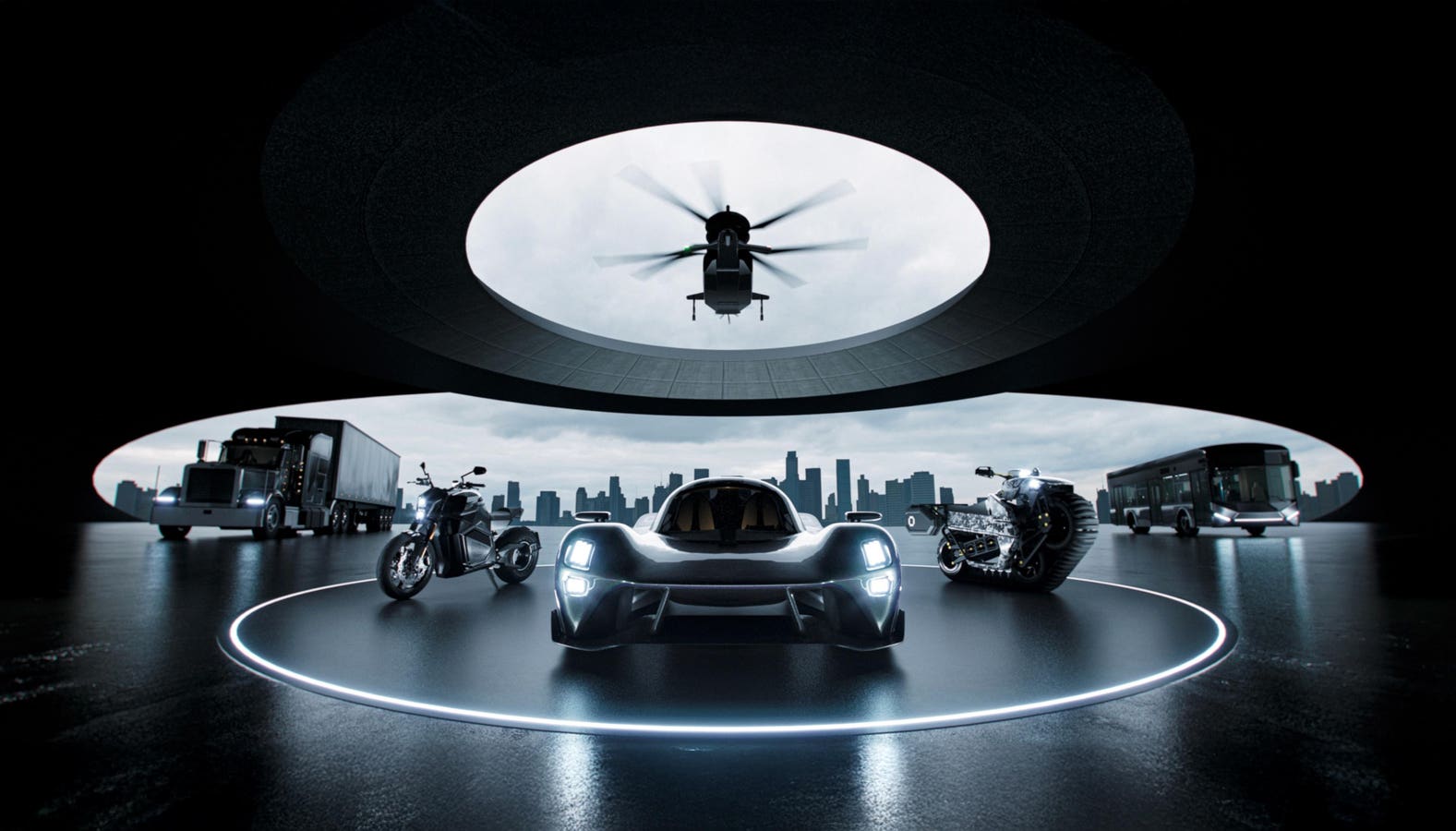The Donut Lab hubless motor technology is broadening out from motorbikes to a host of other electric … More
Five years ago, Verge made headlines with its TS electric motorbike. Not only did this two-wheeler have an incredibly cool-looking, hubless rear motor, but this engine also delivered as much torque as a Pagani Huayra hypercar. Verge never planned to limit itself to bikes, however. Now transformed into Donut Lab, the company has technology that it reckons could revolutionize the design of EV powertrains at every level. I talked to Donut Lab about its plans for EV world domination.
Donut Lab: Motorbikes Were Just The Beginning
“The idea was to find a better way to build EVs,” says Marko Lehtimaki, CEO of Donut Lab. “We started with a motorcycle because it’s one of the hardest form factors in EVs. You need to package a lot of power, torque and range into a small space. But it’s also much easier to have that as your integration hero product than a full-fledged car. That’s how Verge Motorcycles was originally born. But all the time, throughout the few years that we built the initial first product that we brought to the market in early 2023, we were already developing all the components with the idea that one day this will go into all other vehicles.”
Donut Lab was set up with the help of Risto Siilasmaa, former CEO of Nokia and a seasoned entrepreneur who also founded and was CEO of cybersecurity firm F-Secure. He has backed 60 startups, six of which became unicorns, and he sees Donut Lab as another potential billion-dollar company. “Their technology is something that I’m very impressed with as well as the team that is running the company,” he says.
“We decided that to create the absolute best technology for EVs, you have to have all the pieces designed by one party,” says Lehtimaki. “We started with the motor. The basic premise was that the development time of EVs was just way too long, but also the costs involved too great. It’s hundreds of millions or even billions of dollars to create new vehicles from the ground up. We started by asking about some of the areas we could optimize.”
The Donut Lub hubless motor journey started with the Verge TS electric motorbike.
The obvious first target was the drivetrain. Automakers had toyed with putting motors in wheels in the past but struggled with the amount of unsprung mass this added. Nevertheless, the potential benefits are clear. “The reason to remove the drivetrain is that it has over 100 parts costing almost $2,000 in a regular SUV or big car,” says Lehtimaki. “Around 15% efficiency is lost with the power transmission, and that turns into heat, so you need more cooling in your car.” The drivetrain transmission also introduces latency in power delivery.
There are other benefits, too. “It could free up 150 liters of space if you didn’t have a power transmission or a drive train,” says Lehtimaki. The reduction in complexity will also make the vehicle more reliable. “That’s how we came up with this new motor design that is called the Donut Motor. People thought that if that would work, some German motor company would have patented it 60 years ago. But we built it, it worked, then we patented it in every single way so nobody else could build something like it. Then we started to build around it.”
The diameter of the hub motor provides an inherent advantage. With a regular-sized motor “you need a lot of active materials to create the torque and power,” says Lehtimaki. “But if you have all the active materials on a big radius, you can create three times as torque and power per kilogram. That was the beginning of the journey with the motors.” The journey began with the Verge TS. “The hero product was the motorcycle. We released it in early 2023 and immediately started to get quite a bit of attention. We broke the Guinness World Record for the longest journey on a single charge for an EV bike, but also the charging time was 5-10 times faster. That was because we freed up so much space in the body of the motorcycle that we could use very low-density battery cells, which makes the battery much cheaper to produce, but also faster to charge.”
Donut Lab Emerges From Stealth Mode
With the Verge TS getting noticed, Donut Lab was ready to enter its next phase. “In November 2024, we came out of stealth with Donut Lab,” says Lehtimaki. “In January this year at CES, we launched the five-motor family. We were already discussing with quite a few OEMs, but then suddenly it turned into hundreds of companies. That’s the happy chaos that we have been in for now for a couple of months.”
The five motors that Donut Lab released at CES cover a broad range of electric vehicle types, from trucks to drones. “We had already been producing our motorcycles fully homologated for 18 months at the time of CES,” says Lehtimaki. The motorcycle motor has been upgraded since launch. “It’s 21kg and the previous one was over 40kg. We’ve been able to produce the same amount of torque and power, even though the previous motor was already better than anything else out there.”
The Donut Lab hubless motor range now has five members, announced at CES in January 2025.
Alongside this 17in motorcycle motor with 201hp and 1,200Nm of torque, Donut now produces a 21in automotive hub motor weighing 40kg with a gobsmacking 845hp and 4,300Nm of torque. A truck variant of this motor optimized for lower RPM offers 268hp and 3,000Nm. Then there’s a 12in scooter motor weighing just 8kg but still delivering 20hp and 300Nm of torque, plus a 120mm motor with 4hp and 20Nm weighing just 1.5kg and aimed at drone applications. Lehtimaki showed a graph of torque and power per kilogram of its motors compared to other drivetrains on the market. The Donut Lab motors were in a different league to everything else available.
The 40kg automotive motor could be the true gamechanger, however – and not because of the colossal amount of power it can deliver. “It’s about whether you would pay extra for the inefficiency of traditional motors, because they are using double or triple or quadruple the bill of materials,” says Lehtimaki. The low mass of Donut Lab’s technology solves the previous problem associated with hub motors. “With just 40 kilograms added to the wheels even the most professional race drivers cannot tell the difference.”
Beyond Donut Lab Motors
Donut Lab isn’t planning to stop with the hub technology, however. “People associate Donut Lab with the motors,” says Lehtimaki. “That’s deliberate. We knew that we have so much to announce that we needed to split it into a couple of years. Otherwise, it will be too much to sell. But we are working on bringing out our next generation battery technology, which is also groundbreaking – like the donut motor of batteries – as well as our entire software platform. This is even more revolutionary than the hardware, even though the hardware technology is really turning the industry upside down.”
The Verge TS gave a taster of how Donut Lab hopes to change the EV industry.
Lehtimaki is keeping most of the details of the Donut Lab battery technology secret but is more forthcoming about the software. “A regular vehicle manufacturer has different coders with different tools for different control units, because the motor control is very different to program than the battery management,” he says. “We are bringing all of it together. We’re creating the world’s first no-code platform for building the entire EV logic. The system is working through visual state machines and sequence diagrams. This is quite groundbreaking, but also it allows for a much higher level of safety because now everything is interconnected. It will also reduce the time to create full-blown software for your vehicle to less than a 10th. We are already planning to take some of our select smaller customers into trial before the end of the year and then launching next year.”
Until then, though, Donut Lab’s hub motor technology promises to upend electric vehicle design. “If I can produce the same amount of torque and power with one third of the space and weight, that typically means one third of the build materials as well,” says Lehtimaki. “We can be very competitive with the price. You can remove 120 parts and $2,000 from your bill of materials. So you’ll have reduced weights, saved 100 plus liters of space, and achieved better design. It’s a no brainer.”








